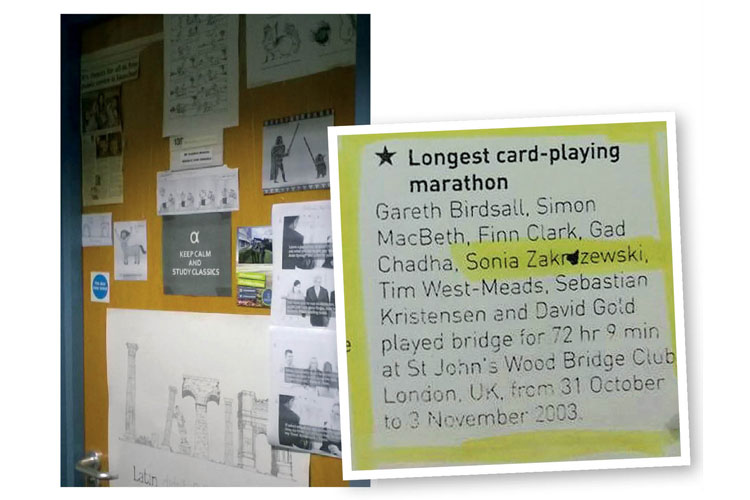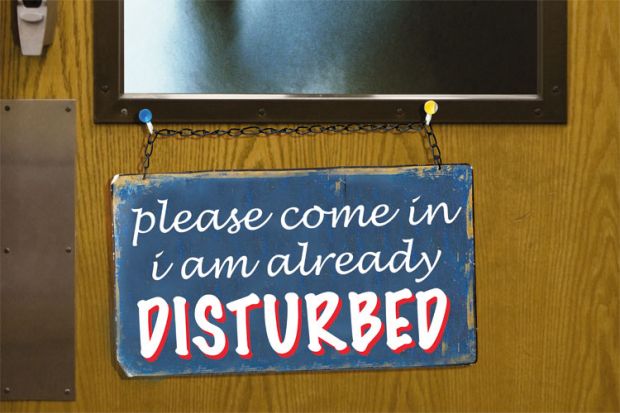“Please come in. I am already disturbed.” So reads the sign on an academic’s door at Ulster University.
In an age of open-plan offices, not every academic has an office door – but among those that do, it seems that few miss the opportunity to make a statement. Through cartoons, quotes or instructions to students, lecturers and professors may choose to protect their privacy or declare their individuality, make clear what they value, or comment on the corporate culture. They may show a face to the world that is welcoming or off-putting, amusing or pedantic.
When we asked readers for examples, we heard about academics who expressed themselves with admirable directness, from a professor who taped pages of the academic handbook to his door highlighting every policy he had violated, to a lecturer who attempted to avoid pointless questions with a sign reading: “I am not Google.” Like the “disturbed” academic, some respondents admit they have used their doors to deter students, announcing: “Please do not disturb unless it’s both urgent and important (to me)”, or, more subtly: “The first Mrs Rochester. Please use care when opening door.” Among the stranger messages was the case of a “Nietzschean” lecturer who declared: “I am not a man; I am dynamite!”
Tara Magdalinski, a lecturer in the School of Public Health, Physiotherapy and Population Science at University College Dublin, illustrates her pedantry with a cartoon of a graffiti artist who suffers from a similar affliction. “I am very particular about grammar, spelling, punctuation and so on,” Magdalinski explains. “My students are told that I am too old and too grumpy for ‘txtspk’, and that a well written and structured piece will always do better than a casual essay that sounds like you’re chatting to friends in a pub.”
Others choose cartoons that relate to their discipline. Evelien Bracke, lecturer in history and Classics at Swansea University, likes to “put comics on my door and things that are relevant to Classics. For the moment, there are some Private Eye things on there alongside the usual comics – the current situation in Greece particularly has sparked Classics-related comics (tragic ones, often).” Old-time Classicists still sometimes enjoy images from Geoffrey Willans and Ronald Searle’s 1950s “Molesworth” books about “the private life of the gerund”, where a Latin grammatical term is reborn as a strange little creature. Other academics report doors in the history department featuring “Wolf Hall plot explained” cartoons and reminders for mediocre students of maths about “labelling your axes” – showing axes of the chopping rather than graphical variety.
There are things to be found on academics’ doors celebrating unusual achievements. Sonia Zakrzewski, associate professor of archaeology at the University of Southampton, has lots of pictures of skulls and skeletons, but also her joint entry in the 2005 Guinness World Records for longest card-playing marathon.
Doors can also feature strange objects, sometimes imbued with great personal significance. Björn Weiler, a professor in the department of history and Welsh history at Aberystwyth University, is not sure why a student left a plastic stick-on lizard on his door, although it may have been because they were discussing “royal zoos and bizarre pets mentioned in medieval chronicles”. Whatever the explanation, he “thought it was quite endearing at the time, and never had the heart to pull it off”.
For Amanda Clare, lecturer in computer science at Aberystwyth, however, her knitted sunflower is not just there to be cheerful but to remind her that Alan Turing studied plant structure and to encourage her to pursue “an ideal” – interdisciplinary work – “that feels under threat and little appreciated”. She explains: “There are many obstacles to interdisciplinary work: the problems of REF-returnability, the problems of discipline silos and norms, the unfamiliar subject material to take on board and a feeling of never quite being up to the job of understanding it all.”
Jamie Medhurst, senior lecturer in media and communication at Aberystwyth University, has stuck to his door a photocopy of John Logie Baird’s 1923 advert from The Times asking for help in “seeing by wireless”. This document is significant, he explains, because it marks the beginning of Baird’s experiments with television “which ultimately led to the BBC collaborating with him on an experimental television service in 1929, the BBC’s own experimental service in 1932 and the world’s first regular high-definition service in 1936”. Since he is working on a book about this, he has displayed the advert “to flag up that history in media studies is important” and to inspire him to finish his book, though he adds that “critics of today’s television output may wish that this humble three-line advert had never appeared”.

A more straightforward statement of disciplinary identity comes from Dan Swanton, a lecturer in human geography at the University of Edinburgh. When Swanton, a cultural geographer researching and teaching everyday urban life, discovered that he had been caught on camera on Google Street View, he chose to pin up the image.
Items encapsulating disciplinary and political commitments can also be a focus for debate. Liz Morrish, principal lecturer in English, culture and media at Nottingham Trent University, has posted a graphic based on research that found that men and women in business were rated using rather different sets of adjectives and nouns. While men were described as “exceptional”, “extraordinary” and even “fabulous”, women were “dependable”, “hard-working” or “meticulous”. This has proved a highly effective teaching tool in Morrish’s final-year undergraduate course on language and gender, where she “sometimes finds that students are resistant to the thought that language can perpetuate sexism or male dominance”.
“If there is one thing that engages our students, it is looking at how theory plays out in real-life contexts,” she says. “This graphic works wonderfully in starting discussions about, for example, whether women and men will be evaluated differently in appraisals or in references throughout their careers…Students very often have a different opinion of the apparent neutrality of language and the workplace when they finish the course.”
“Supersnooper” social psychologist Sam Gosling, professor of psychology at the University of Texas at Austin, has long been fascinated by how people reveal their personalities in the environments they create around them. His studies included “a lot of material on the doors of offices and student dorm rooms. It’s a classic example of what I call ‘identity claims’, which are when someone wants to broadcast a message about themselves to others (other good examples are T-shirts with your university or favourite band on them, a quote at the foot of your email or a bumper sticker). These are deliberate statements, so there’s a temptation to think that people might be disingenuous or manipulative, but research done by us and others suggests they are typically authentic expression of the self. This is because they are clearly for the benefit of others (the occupant is typically on the other side of the door) and because there is no doubt about who the signals are coming from.”
Although we learned of many creative and amusing things that academics have done with their doors, we also received some salutary reminders in comments such as: “Remember when academics had doors?” and “Large shared offices put paid to this now”. Yet we can only end with an example of a cosmic struggle fought between neighbouring academics.
Emily Fowler, a graduate teaching assistant in social sciences at Edge Hill University, puts up a daily entry from the Evil Overlord List – a comic guide for superheroes, compiled by sci-fi fans, on how to avoid the silly mistakes they seem constantly to make in stories. This is partly because she “enjoys silliness in my daily life. A good deal of what we teach can be sad and upsetting, and it’s nice to have something to counter that”. Yet, according to Fowler, the list also “contains important lessons” – about “disregarding the status quo, approaching problems in a logical rather than [reactive] manner, and the value of work done well. For instance, today’s entry is no. 38: ‘Once my power is secure, I will destroy all those pesky time-travel devices.’ Many a sub-par villain has ignored this rule to their own detriment.”
Since Fowler’s office is just by the staff kitchen, her door attracts regular comments. “Students use it as an icebreaker when they’re nervous, or as a framework to discuss academic topics,” she says. “I don’t tend to call attention to it, except with my next-door neighbour. Her door has lovely inspirational quotes and we are currently engaged in an epic battle of good versus evil.”
POSTSCRIPT:
Print headline: Beware of the professor
Register to continue
Why register?
- Registration is free and only takes a moment
- Once registered, you can read 3 articles a month
- Sign up for our newsletter
Subscribe
Or subscribe for unlimited access to:
- Unlimited access to news, views, insights & reviews
- Digital editions
- Digital access to THE’s university and college rankings analysis
Already registered or a current subscriber? Login




